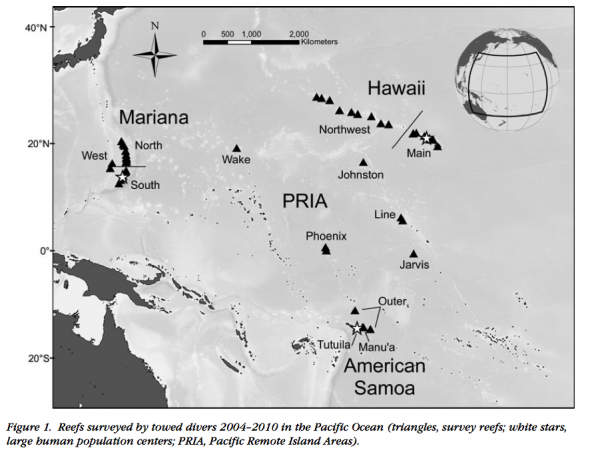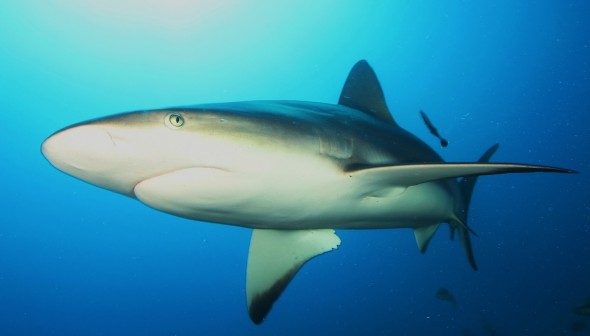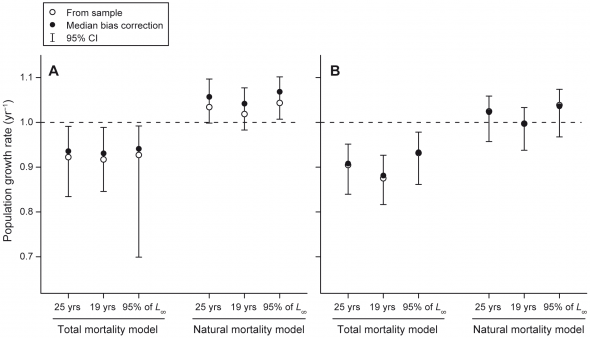“[The] density of reef sharks has declined to 3–10% of baseline levels”
This is the take-home finding from one of two new papers that help clarify just how much reef shark populations have declined. Nadon et al. 2012, Re-creating missing population baselines for Pacific reef sharks, just came out in the journal Conservation Biology. The team used a new database of “towed-diver” surveys to look at how reef shark density could be influenced by factors like human population density and ocean temperature (Also see Juliet Eilperin’s WaPost piece in this work here.)
The results of Nadon et al add to a large and growing body of research that has estimated and documented just how much of the world’s sharks are gone (see an excellent round-up of this science by WhySharksMatter here). Much of the past work on global shark population decline has been based on fisheries catch data and scientific surveys. The former are called “fisheries-dependent data” and are usually based on some measure of Catch Per Unit Effort, such as the number of sharks caught per thousand hooks in the long-line fishery. The later are visual surveys collected by scientists using SCUBA (so-called fisheries-independent data), where divers swim along a “transect” line (often 30-50 m long) just above the sea floor. The divers identify and estimate the length of sharks they encounter within a given swath of reef. This gives you an estimate of reef shark density, however, it can be biased if the sharks are attracted to the divers, as they often are in remote locations.
Both types of data and analyses based on them have been criticized. So Nadon et al used a different technique to estimate the historical abundances of reef sharks and also how much they have been reduced, presumably by fishing.
Abstract: Sharks and other large predators are scarce on most coral reefs, but studies of their historical ecology provide qualitative evidence that predators were once numerous in these ecosystems. Quantifying density of sharks in the absence of humans (baseline) is, however, hindered by a paucity of pertinent time-series data. Recently researchers have used underwater visual surveys, primarily of limited spatial extent or nonstandard design, to infer negative associations between reef shark abundance and human populations. We analyzed data from 1607 towed-diver surveys (>1 ha transects surveyed by observers towed behind a boat) conducted at 46 reefs in the central-western Pacific Ocean, reefs that included some of the world’s most pristine coral reefs. Estimates of shark density from towed-diver surveys were substantially lower (<10%) than published estimates from surveys along small transects (<0.02 ha), which is not consistent with inverted biomass pyramids (predator biomass greater than prey biomass) reported by other researchers for pristine reefs. We examined the relation between the density of reef sharks observed in towed-diver surveys and human population in models that accounted for the influence of oceanic primary productivity, sea surface temperature, reef area, and reef physical complexity. We used these models to estimate the density of sharks in the absence of humans. Densities of gray reef sharks (Carcharhinus amblyrhynchos), whitetip reef sharks (Triaenodon obesus), and the group “all reef sharks” increased substantially as human population decreased and as primary productivity and minimum sea surface temperature (or reef area, which was highly corre- lated with temperature) increased. Simulated baseline densities of reef sharks under the absence of humans were 1.1–2.4/ha for the main Hawaiian Islands, 1.2–2.4/ha for inhabited islands of American Samoa, and 0.9–2.1/ha for inhabited islands in the Mariana Archipelago, which suggests that density of reef sharks has declined to 3–10% of baseline levels in these areas.
The analysis was based on 1607 towed-diver surveys of 46 reefs (mapped below as black triangles):

The divers were literally towed behind a boat and told to count sharks! It is kind of a sketchy method, since the scientists are effectively shark bait. It takes a strong will to focus on counting the sharks in front of and below you, while ignoring the urge to look behind you!
The figure from Nadon et al. 2012 below is the key finding: sharks are far more abundant on reefs adjacent to uninhabited islands than when people are present. (Presumably the sharks are being fished on the islands with people but it is also possible that people are fishing out the shark’s food source, i.e., other fishes). Furthermore, there is a sharp threshold of the effect of human density – essentially any people can lead to extreme shark population declines. The reason for this is that as long-lived vertebrates, shark populations are very sensitive to the additional, unnatural mortality caused by hunting. In simple terms, it is really easy to hunt them into local extinction, which isn’t the case for many faster growing, smaller species with shorter life spans.
Considered in isolation, this finding isn’t necessarily proof of why people and sharks tend not to coexist – after all, maybe the sharks ate all the people on the uninhabited islands! Or perhaps some form of pollution, possibly even noise pollution, drives the sharks away. You’ve always got to be careful when interpreting non-experimental pattern data like this (correlation doesn’t equal causation, etc). But the reality is that we have a mountain of other types of evidence, when considered together, leads me to the conclusion that it is highly likely that people are fishing out the sharks on the human-inhabited islands.

The second paper (Hisano et al 2011) takes an entirely different approach to estimate the effects of fishing on shark populations. The team from James Cook University built a mathematical population model based on known characteristics of the demography of two shark species that inhabit Australia’s Great Barrier Reef (grey and whitetip reef sharks). The population model describes the dynamics of the populations and can be used to estimate whether the population would be growing or shrinking under different scenarios. For example, with and without fishing pressure and the additional mortality it leads to.
From the abstract: Overfishing of sharks is a global concern, with increasing numbers of species threatened by overfishing. For many sharks, both catch rates and underwater visual surveys have been criticized as indices of abundance…Here, focusing on two reef shark species on the Great Barrier Reef, Australia, we estimated natural and total mortality rates using several indirect methods, and determined the population growth rates resulting from each…Multiple models produced highly concordant natural and total mortality rates, and associated population growth rates, once the uncertainties associated with the individual estimates were taken into account. Consensus estimates of natural and total population growth across multiple models support the hypothesis that these species are declining rapidly due to fishing, in contrast to conclusions previously drawn from catch rate trends. Moreover, quantitative projections of abundance differences on fished versus unfished reefs, based on the population growth rate estimates, are comparable to those found in previous studies using underwater visual surveys. These findings appear to justify management actions to substantially reduce the fishing mortality of reef sharks.
Figure 4 of Hisano et al 2011: Estimates of consensus natural and total population growth rate for two reef shark species. Estimates were obtained with models with longevity set to 25 years, 19 years and time to achieve 95% ofL? (sample estimate: 52 and 50 years, respectively) for (A) T. obesus (white tip reef shark) and (B) C. amblyrhynchos (grey reef shark) on the Great Barrier Reef. For each method, an open circle indicates the (raw) sample estimate, which was obtained using maximum likelihood parameter estimates from analysis of the empirical data, a closed circle indicates the bootstrap bias-corrected estimate, and whiskers indicate 95% bias-corrected, accelerated (BCa) bootstrap confidence intervals. Dashed lines indicate the threshold between population growth (above) and decline (below).
Put simply, the demographic models predict exactly what Nadon et al. 2012 (and many other studies) have found: shark fishing leads to the disappearance of sharks. You can see this in the graph above by comparing the predicted population growth rates for the “Total mortality model” and the “Natural mortality model” for either species. Values above the horizontal dashed line indicate a population is increasing while points below are shrinking. If a population decreases for long, it goes extinct. The difference between the two scenarios is the addition of mortality caused by fishing to the Total mortality model; i.e., all causes of natural mortality + fishing-related mortality = total mortality.
There is still a lot we don’t know about reef sharks and how we are impacting their populations, but there is little doubt left that just a small amount of fishing can quickly nearly eliminate them from local ecosystems.
See more of our coverage of shark fishing here.


Leave a Reply to Sam Cancel reply